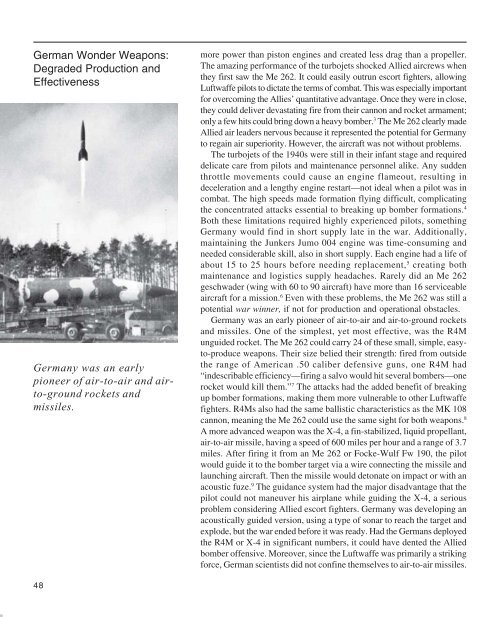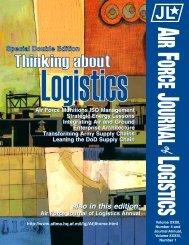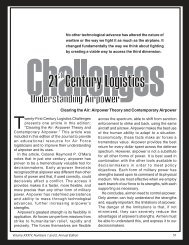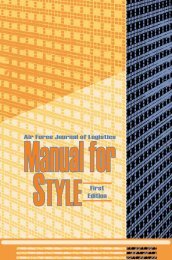Old Lessons, New Thoughts - AF Logistics Management Agency
Old Lessons, New Thoughts - AF Logistics Management Agency
Old Lessons, New Thoughts - AF Logistics Management Agency
Create successful ePaper yourself
Turn your PDF publications into a flip-book with our unique Google optimized e-Paper software.
German Wonder Weapons:<br />
Degraded Production and<br />
Effectiveness<br />
Germany was an early<br />
pioneer of air-to-air and airto-ground<br />
rockets and<br />
missiles.<br />
48<br />
more power than piston engines and created less drag than a propeller.<br />
The amazing performance of the turbojets shocked Allied aircrews when<br />
they first saw the Me 262. It could easily outrun escort fighters, allowing<br />
Luftwaffe pilots to dictate the terms of combat. This was especially important<br />
for overcoming the Allies’ quantitative advantage. Once they were in close,<br />
they could deliver devastating fire from their cannon and rocket armament;<br />
only a few hits could bring down a heavy bomber. 3 The Me 262 clearly made<br />
Allied air leaders nervous because it represented the potential for Germany<br />
to regain air superiority. However, the aircraft was not without problems.<br />
The turbojets of the 1940s were still in their infant stage and required<br />
delicate care from pilots and maintenance personnel alike. Any sudden<br />
throttle movements could cause an engine flameout, resulting in<br />
deceleration and a lengthy engine restart—not ideal when a pilot was in<br />
combat. The high speeds made formation flying difficult, complicating<br />
the concentrated attacks essential to breaking up bomber formations. 4<br />
Both these limitations required highly experienced pilots, something<br />
Germany would find in short supply late in the war. Additionally,<br />
maintaining the Junkers Jumo 004 engine was time-consuming and<br />
needed considerable skill, also in short supply. Each engine had a life of<br />
about 15 to 25 hours before needing replacement, 5 creating both<br />
maintenance and logistics supply headaches. Rarely did an Me 262<br />
geschwader (wing with 60 to 90 aircraft) have more than 16 serviceable<br />
aircraft for a mission. 6 Even with these problems, the Me 262 was still a<br />
potential war winner, if not for production and operational obstacles.<br />
Germany was an early pioneer of air-to-air and air-to-ground rockets<br />
and missiles. One of the simplest, yet most effective, was the R4M<br />
unguided rocket. The Me 262 could carry 24 of these small, simple, easyto-produce<br />
weapons. Their size belied their strength: fired from outside<br />
the range of American .50 caliber defensive guns, one R4M had<br />
“indescribable efficiency—firing a salvo would hit several bombers—one<br />
rocket would kill them.” 7 The attacks had the added benefit of breaking<br />
up bomber formations, making them more vulnerable to other Luftwaffe<br />
fighters. R4Ms also had the same ballistic characteristics as the MK 108<br />
cannon, meaning the Me 262 could use the same sight for both weapons. 8<br />
A more advanced weapon was the X-4, a fin-stabilized, liquid propellant,<br />
air-to-air missile, having a speed of 600 miles per hour and a range of 3.7<br />
miles. After firing it from an Me 262 or Focke-Wulf Fw 190, the pilot<br />
would guide it to the bomber target via a wire connecting the missile and<br />
launching aircraft. Then the missile would detonate on impact or with an<br />
acoustic fuze. 9 The guidance system had the major disadvantage that the<br />
pilot could not maneuver his airplane while guiding the X-4, a serious<br />
problem considering Allied escort fighters. Germany was developing an<br />
acoustically guided version, using a type of sonar to reach the target and<br />
explode, but the war ended before it was ready. Had the Germans deployed<br />
the R4M or X-4 in significant numbers, it could have dented the Allied<br />
bomber offensive. Moreover, since the Luftwaffe was primarily a striking<br />
force, German scientists did not confine themselves to air-to-air missiles.





